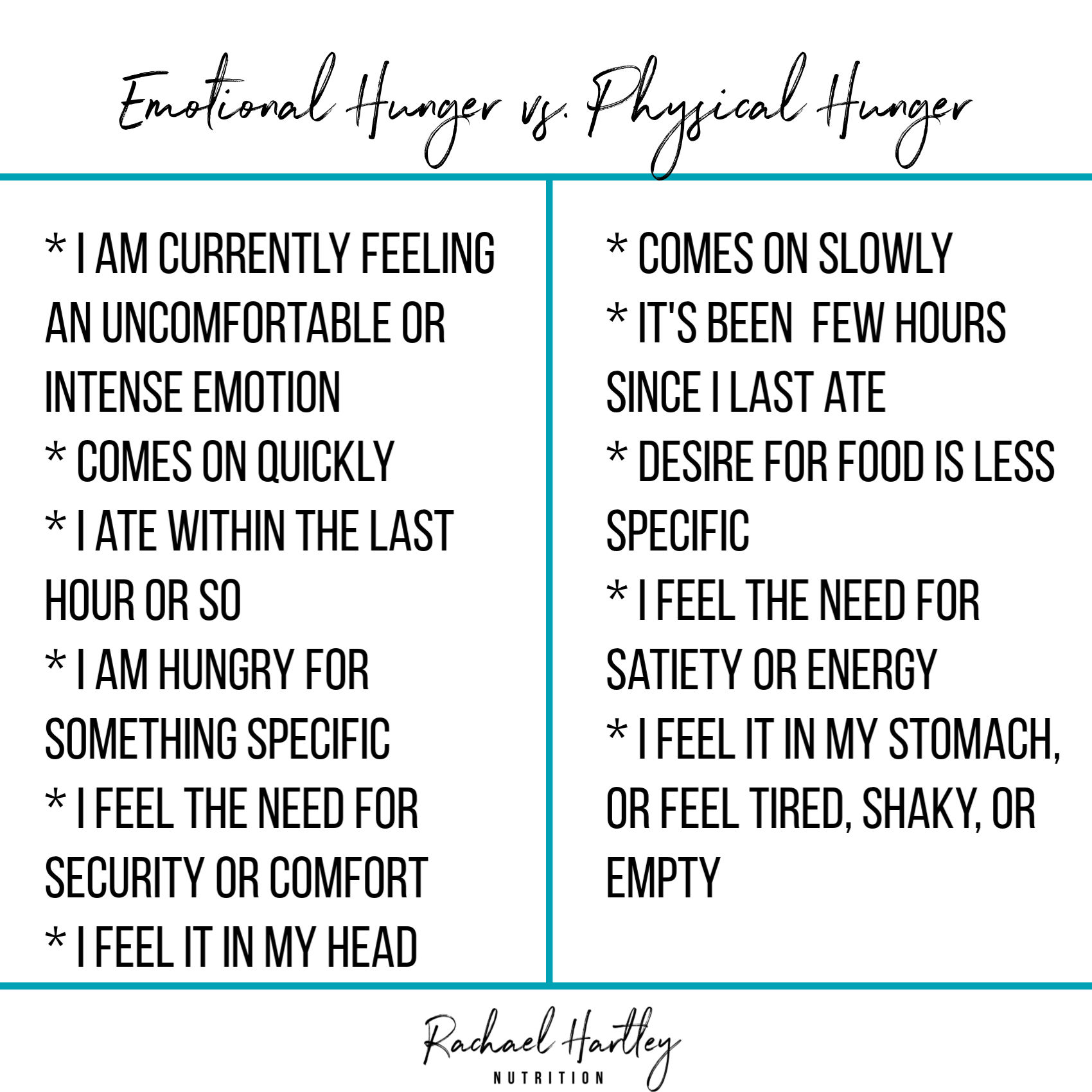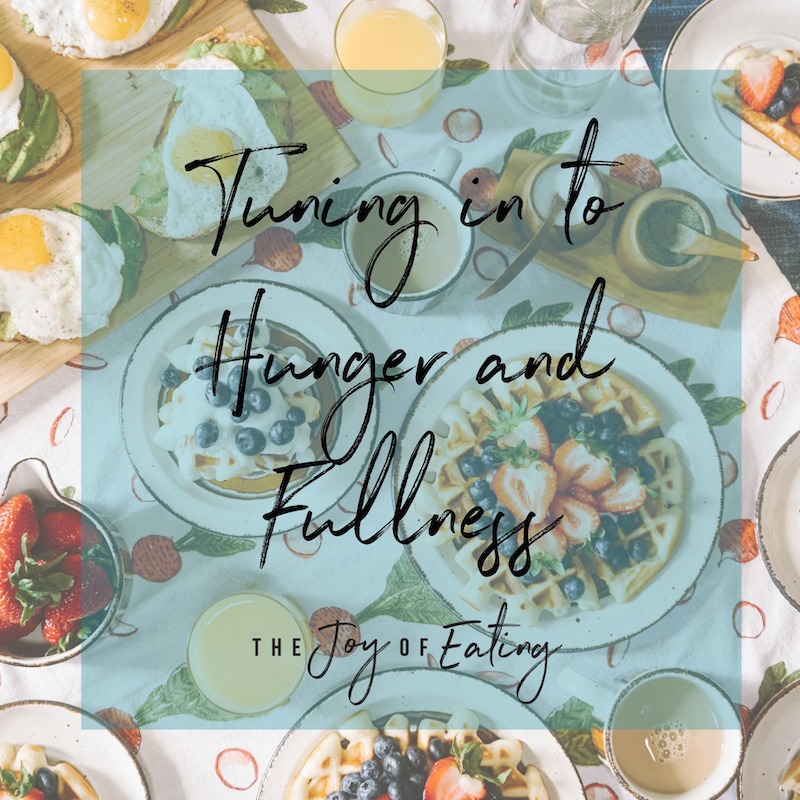Four Types of Hunger in Intuitive Eating: Physical Hunger, Emotional Hunger, Taste Hunger and Practical Hunger
In intuitive eating, you hear a lot about hunger. But did you know there are more ways to experience hunger than just physical hunger? This post explores the four types of hunger in intuitive eating - physical, emotional, taste and practical - and how to respond to each.
Us non-diet dietitians talk a lot about hunger in intuitive eating. There’s a reason honor your hunger is the second principle of intuitive eating - it’s incredibly important! As I remind my clients, honoring your hunger and fueling your body appropriately creates space for you to engage with the other principles of intuitive eating.
That said, there’s a lot more to honoring your hunger than simply eating when you feel a rumble in your stomach. Did you know there are other types of hunger outside of physical hunger? In intuitive eating there are four types of hunger, all of which are important to be able identify and have tools to navigate.
Since it’s a frequent topic of discussion in session, I’m writing this blog post as a resource for my clients, and hopefully to help others that are reading it understand what’s fueling the desire for food, and in making decisions around food that feel good!
The Four Types of Hunger in Intuitive Eating
Physical Hunger
Physical hunger stems from a need for energy from food. Just like when our bladder stretches, it signals a need to pee, or when our mouth feels dry, it signals a need to hydrate, when we feel the physical signs of hunger, it means we need food. We normally think of hunger as an empty or gnawing sensation in the stomach, but you can also experience signs of hunger outside the stomach. Sometimes physical hunger can present as fatigue, anxiety, headaches, shakiness, or simply thinking more about food. The only way to take care of physical hunger is to eat! Contrary to what Cosmo magazine taught you in 1998, chewing gum or drinking water isn’t helpful for making physical hunger go away - it might suppress hunger for a short period, but like a beach ball being pushed underwater, it will pop back up wildly. I’ll also add that there’s no need to suppress physical hunger. How cool is it that your body can signal when your energy needs are low? Like an energy gage on your car, hunger cues are a helpful tool for making sure you’ve got the fuel you need.
Taste Hunger
Taste hunger occurs when you have a taste for a specific food. It may present outside of physical hunger or alongside physical hunger. Basically, taste hunger is when a food just sounds good! An example of pure taste hunger might be when you’ve just eaten a satisfying meal at a restaurant and are feeling quite satisfied, but then you see the dessert menu and feel taste hungry when you see something appealing on it. Remember, taste hunger is valid hunger! You are allowed to eat when you’re not hungry, just because something looks or sounds good. However, when you know more tasty foods are coming, you might not feel an urgency to fulfill every brief moment of taste hunger you experience.
Emotional Hunger
Emotional hunger is when you have an unmet emotional need that presents itself with a desire to eat food. This is what is often referred to as “emotional eating,” a phrase I kinda sorta hate, but people know what I’m talking about when I say it. Essentially it is using food as a tool to cope with, soothe/comfort, numb/distract, or amplify an emotion - either a positive or negative emotion. Emotional eating isn’t off limits in intuitive eating. As I discuss in this blog post on emotional eating, food can be one way to soothe, but it’s helpful to have other options AND to give yourself permission to eat emotionally, as that creates space for the food to actually do it’s job and help you feel better.
Sometimes it can be hard to distinguish physical and emotional hunger. Some ways to tell if it’s an emotional hunger is when it comes on quickly in conjunction with an intense emotion. You might have also recently eaten, or feel the need for comfort, security or distraction more so than a need for energy. Below is a graphic I use with clients to help distinguish emotional and physical hunger. I will add that under physical hunger I note that the desire for food is less specific, and I think that is certainly the case when it’s mild physical hunger, but I’ve found both for myself and for many clients that when you are intensely hunger, often times your hunger can get REALLY specific.
Practical Hunger
Practical hunger isn’t really hunger per say, but rather a need to eat in response to anticipated physical hunger that you won’t be able to satisfy. An example might be eating a large meal before a long plane ride or having lunch during a set lunch break, even though you’re not hungry at the moment, simply because it’s your time to eat. Here’s a post I wrote on practical hunger.
How to Satisfy Different Types of Hunger
Eating is an appropriate response to all of these hungers. I will repeat, ALL of these hungers are valid, and food is an appropriate response to each . Sometimes the messaging around intuitive eating can make it sound as if it’s wrong to eat when you aren’t physically hungry, whether for taste or emotional reasons, but this is an oversimplification at best, and actively harmful messaging at worst. It is human to eat to soothe emotions. It is human to seek pleasure from food. To deny ourselves these things goes against basic human instinct and fuels feelings of deprivation and stress around food.
That said, it’s helpful to know which hunger (or hungers) you are experiencing, as it gives you helpful information about how you’d like to satisfy it. Here’s an extremely oversimplified tool for navigating the different types of hunger.
Physical hunger —> EAT
Emotional hunger —> Soothe that emotion with OR without food. This blog post shares how to create a toolbox for emotional eating.
Taste hunger —> You can satisfy that taste hunger, or you can hold off (giving yourself FULL permission to satisfy it later) if now isn’t a good time (i.e. you’re too busy to procure the food, you’re already full and don’t want to be stuffed, etc).
Practical hunger —> eat or make plans to eat/procure food.
Again, that is super simplified, but hopefully a helpful place to start in making food choices. I’ll also add that if you have a long history of restriction, the idea of pausing or not satisfying a hunger with food might feel really restrictive and hard for you right now. If so, that’s OK! It won’t always feel that way, but for now you are right where you need to be on your journey.
What if I’m experiencing multiple types of hunger at once?
The different types of hunger don’t always occur in isolation. You can be feeling physically hungry AND emotionally hungry at the same time. You can be feeling emotionally hungry AND taste hungry. You can be feeling all three at once! Knowing which hungers are occurring can help you give yourself options of how to satisfy.
For example, you might be experiencing physical hunger along with a taste hunger for cookies. Since cookies are delicious, but not really filling, you might choose to pair it with another food to make it a more satisfying snack, like cookies and milk or cookies and a piece of fruit. Or, you might decide to satisfy physical hunger first and then see if you’re still in the mood for cookies, since physical hunger can sometimes drive cravings for sweets. Neither option is wrong or right, just two different approaches that might feel better or worse in different situations!
What if I’m unsure which type of hunger I’m experiencing?
Sometimes you won’t know which type of hunger you’re experiencing, especially if you’re feeling disconnected from your body or are new to intuitive eating. In these situations, I think it’s helpful to give yourself permission to eat what you’re in the mood for and see if it actually addresses your hunger. Think of this as an experiment for helping you learn what each type of hunger feels like for you. It may feel scary to “get it wrong,” but at the end of the day it’s just food! It’s OK to have learning experiences with it.
Interested in learning more about intuitive eating? We work with clients virtually and out of our Columbia, SC office helping them foster a healthier relationship with food and feed themselves with confidence. Learn more about our practice philosophy and reach out if you’d like to work together. We are in network with BCBS.
If this blog post on types of hunger was helpful, follow my intuitive eating Pinterest board for more support.







